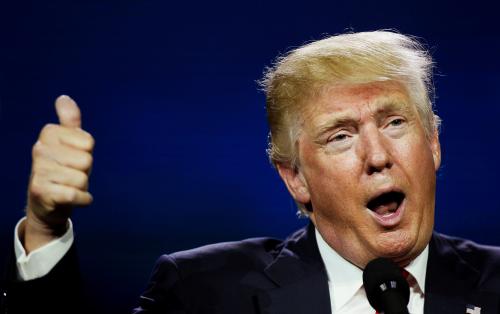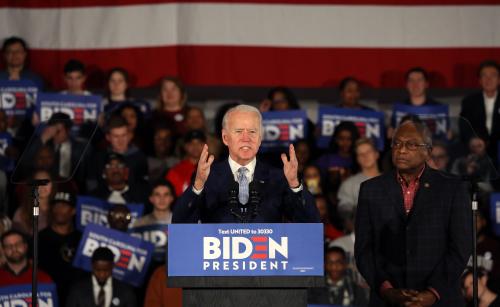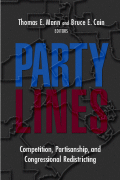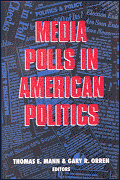The upset victory of Democrat Conor Lamb in a special election last week, for a seat in a Pennsylvania district that President Trump won by a whopping 20 points, has Democrats crowing, and understandably so. But amid the celebrating, no one seems to be complaining, or even noticing, that Lamb did not owe his nomination to the voters. Rather, he was chosen to run by 554 local Democratic Party grandees.
“Two things are striking,” writes Brookings’s E.J. Dionne in The Washington Post. “In the end, Lamb won the backing of all wings of his party; and he was picked by a party committee, not in a primary. The question is whether primaries will allow Lamb-like nominees to emerge in districts where profiles such as his offer Democrats their best chance of snatching seats.”
It is indeed a good question, and important for reasons that go beyond Democrats’ short-term electoral outlook prospects. Here at Brookings, my colleague Elaine Kamarck, as well as political scientist Raymond La Raja and I, argue for a stronger and earlier (though not exclusive) party role in candidate selection. The Pennsylvania special election offers a reminder of why.
First, party officials are in the business of winning general elections. That is not to say they make all the right calls or should (or do) ignore the grassroots. In the Pennsylvania congressional race that Lamb won, the Republicans, too, relied on party insiders to choose their nominee; thanks to internal politicking and confidence about holding the seat, they chose a mediocre candidate over a younger contender who might have prevailed. There are no guarantees in politics.
Still, parties’ incentives are different from those of primary voters, who often prioritize ideological purity, parochial interests, or visceral protest. The party, by contrast, needs to try to match the candidate to the whole district, not just to the primary electorate. And it needs to consider whether the candidate, if elected, could provide substantively competent and politically reliable service in office—an essential filter if we want Congress to work. On all of those counts, Conor Lamb looks like a home run.
Second, and more fundamental: candidate selection by voters may seem more (small-d) democratic, but it is often less representative. After all, democratic processes and representative outcomes are not at all the same thing, a point James Madison made in Federalist 10. Today there is a vast literature in political science and economics on the many ways in which seemingly democratic voting can produce perverse and undemocratic outcomes. Organized interests wield disproportionate clout in low-turnout elections, cognitive biases distort judgment, and different voting processes produce different outcomes, such that there is no one “right” outcome, even in principle. (Benjamin Wittes and I summarize some of that material here.)
A case in point is Donald Trump, who, by picking off opponents in a crowded field one by one, won the Republican presidential nomination without majority support in the party—and then went on to win the presidency without majority support in the country. In 2016, according to The New York Times, the two presidential candidates won their nominations with the combined approval of only 14 percent of Americans who are eligible to vote.
The problem is even more acute in races for lower offices, such as the U.S. House. In down-ballot and off-year races, turnout in primaries is notoriously low; in 2010, for example, turnout even in highly contested House primaries averaged less than 8 percent of the voting-age population. Those who do turn out are often ideological and immoderate relative to the larger population. Many have only a vague if not downright mistaken notion of candidates’ positions. In a split field where there is no runoff, a primary candidate can win with a narrow plurality, which implies a candidate can obtain the nomination with the support of three or four percent of the voting-age population.
In other words, the primary system may be democratic, but it is not necessarily representative. As the political scientists Christopher Achen and Larry Bartels write, “Systematic comparisons of ‘inclusive’ and ‘centralized’ parties have found that greater ‘transparency, participation and accessibility of intra-party decisions’ makes parties slightly less representative of voters than in ‘centralized’ systems where party elites choose the candidates.”
Which brings us back to Conor Lamb. Evidence from political science finds that party insiders often do a good job identifying qualified candidates who are acceptable to multiple factions and able to win. Lamb is a case in point.
That is not to say, again, that the public should be shut out. But, as Kamarck has argued, screening candidates before the voters weigh in is a good idea—and was standard practice in the United States until just a few years ago.
Would the public accept a shared or diminished role in selecting candidates? Conventional wisdom says no. But no one is questioning Lamb’s legitimacy, even though insiders nominated him without voter input. Moreover, he received the seal of approval that matters most: that of the general electorate in a district where, clearly, not just any Democrat could have won. Partisans want (or should want) candidates who are electable, and the public wants (or should want) candidates who are competent, and we all want (or should want) office-holders who are representative. As the Pennsylvania race reminds us, primaries are not the only way, or reliably the best way, to meet those goals.










Commentary
Score one for the smoke-filled room: Why Conor Lamb’s victory was a win for party politicians
March 21, 2018